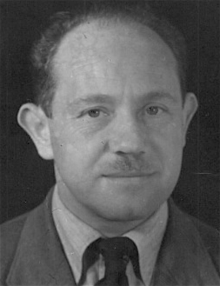
Harry Rosenthal was born in Posen [now known as Poznán], Poland, on 3 May 1892. He studied at the Technische Hochschule in Munich (1911-14) and, after military service, at the Technische Hochschule in Berlin (1917-19). In 1919 he received his Dip. Ing. Arch. and between 1919-23 was employed as an architectural assistant in the offices of Bruno, G. Jacobovitz, Gause & Paetzold and Hans Poelzig. Rosenthal joined the Bund Deutscher Architekten (BDA) and the following year became a member of the Deutscher Werkbund (DWB). In 1923 Rosenthal established his own independent architectural practise in Berlin. Over the next decade he designed several private houses in the Berlin area.
Two photographs of a house and a photograph of a fireplace in a studio designed by Rosenthal are illustrated in 'Decorative Art' 1928 (pp.77, 108); a photograph of a timber weekend home designed by him is illustrated in 'Decorative Art' 1929 (p.97); and photographs of a weekend bungalow at Cladown, near Berlin, and the living room of a weekend house, designed by Harry Rosenthal are illustrated in 'Decorative Art' 1932 (pp.124, 139).
Among his clients were the writer Arnold Zweig, the playwright and critic Julius Bab, the painter Bruno Krauskopf and the sculptor Josef Thorak. He also designed apartments and exhibitions.
Following the rise to power of the National Socialists in Germany 1933, Rosenthal emigrated to Palestine and opened an architectural office in Haifa. Projects undertaken by Rosenthal during his years in Palestine included town planning schemes and the design of shops and housing. He also designed a prefabricated house, the 'Eternit' house for the Levant Fair held in Tel Aviv in 1934.
In 1937 Rosenthal visited the UK where he applied to practise as an architect. His request was accepted and he moved to England in 1938. Finding that opportunities to work as an architect were limited he decided to pursue an alternative career as a designer. In 1939 he was elected to the National Register of Industrial Art Designers (NRD). With the outbreak of war Rosenthal was briefly interned. Following his release he was employed as a senior draughtsman by K.J. & A. Sommerfeld Ltd., a firm in Shropshire that specialised in the manufacture of emergency runways and portable roadways, used by the military.
In 1946 Rosenthal was elected a Member of the Society of Industrial Artists (MSIA), however, during the postwar years in Britain he evidently found it difficult obtain work as a designer and his attempts to re-establish his practise as an independent architect were unsuccessful. Between 1949-55 he was employed as an assistant architect by Middlesex County Council.
In 1956 he returned to freelance work as a designer. His entry in the Register of Members of the Society of Industrial Artists [later Society of Industrial Artists and Designers] from 1956-65 list his areas of expertise as woven and printed textiles, product design, engineering design and furniture.
Rosenthal lived for many years at 102 Greencroft Gardens, London NW6. He died in London on 17 January 1966
Benton, Charlotte. A different world: emigre architects in Britain 1928-1958. London: RIBA Heinz Gallery, 1995
Claus, Sylvia. Harry Rosenthal (1892 - 1966). Architekt und Designer in Deutschland, Palästina, Grossbritannien. Zürich: gta Verlag, 2006 [ISBN 10: 385676156XISBN 13: 9783856761561]